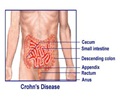A genetic mutation that is linked to colon cancer has been traced back to an English couple that came to North American Colonies in 1630s.
Researchers from Huntsman Cancer Institute (HCI) at The University of Utah have discovered a founder mutation, a mutation that has been traced from many individuals in the present-day population back to a common ancestor, which may contribute to a significant percentage of colon cancer cases in the United States.The team identified two large families - one in Utah and one in New York - that carry the couple's genetic mutation, responsible for an increased risk of colorectal cancer.
The team discovered that the two families share common ancestors - a couple who came to America from England in the 1630s, about the time of the Pilgrims.
“The fact that this mutation can be traced so far back in time suggests that it could be carried by many more families in the United States than is currently known,” says Deborah Neklason, Ph.D., a University of Utah research assistant professor and leader of the study.
“In fact, this founder mutation might be related to many colon cancer cases in the United States,” she added.
Colorectal cancer is the third-leading cause of cancer death in the United States. It will affect 153,000 Americans in 2008, according to the American Cancer Society, and will kill 52,000.
Advertisement
The mutation causes a condition called attenuated familial adenomatous polyposis (AFAP). Without proper clinical care, people with the AFAP mutation have a greater than 2 in 3 risk of colon cancer by age 80, compared to about 1 in 24 for the general population. Yet the cancer can be prevented with proper screening and care.
Advertisement
However, she explains, clinical recognition of AFAP can be difficult because colon cancer develops on average in a person’s 50s and the majority of sporadic, or non-hereditary, colon cancers occur after the age of 50.
The Utah family in this study has more than 7,000 descendants spanning nine generations recorded in the Utah Population Database (UPDB), a shared resource for genetics research housed at HCI.
Known individuals in this one family account for 0.15 percent of all colorectal cancers reported in Utah from 1966 to 1995. Based on that percentage, researchers expected to see eight cases of colon cancer from this family among the over 5,000 reported between 1996 and 2003.
"This study highlights that you need to pay attention to your family history. With intervention to remove the polyps, the risk goes to near nothing,” Neklason said.
The study is published in Clinical Gastroenterology and Hepatology.
Source-ANI
LIN/M











